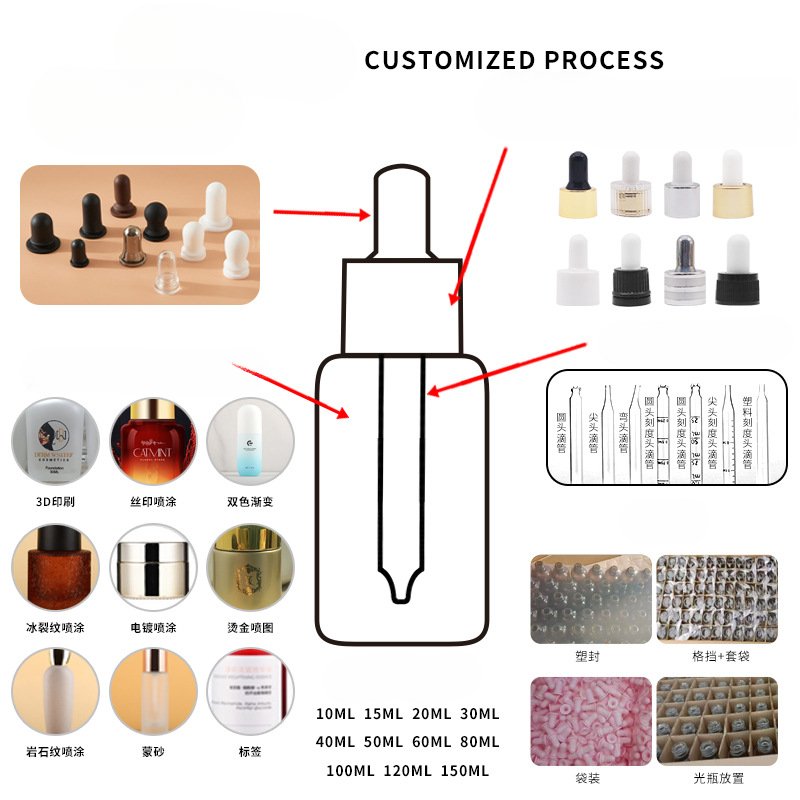Glass dropper bottles have become an essential packaging solution in the beauty, cosmetic, pharmaceutical, and essential oil industries. Their precision dispensing, elegant appearance, and excellent product preservation properties make them a preferred choice for brands looking to combine functionality with aesthetic appeal. This comprehensive guide explores the entire custom glass dropper bottle manufacturing process, from initial design concepts to final product delivery, providing valuable insights for businesses considering custom packaging solutions.
Introduction to Glass Dropper Bottles
Glass dropper bottles represent a sophisticated packaging solution that has gained tremendous popularity across multiple industries. These bottles consist of two primary components: a glass container and a dropper assembly that typically includes a glass pipette, rubber bulb, and plastic or metal collar. The design offers precise liquid dispensing, making it ideal for products where dosage control is crucial.
The versatility of glass dropper bottles extends to various product categories. In the cosmetics industry, they’re commonly used for serums, facial oils, and other concentrated skincare formulations. The pharmaceutical sector utilizes them for medicinal oils, tinctures, and eye drops. Essential oil producers favor glass dropper bottles for their ability to preserve the integrity of volatile compounds while allowing easy application. Even the food industry has adopted similar designs for specialty oils and flavorings.
One of the key advantages of glass dropper bottles is their superior product protection. Glass, as a material, is non-reactive and impermeable, ensuring that the contents remain uncontaminated and maintain their potency over time. Unlike plastic alternatives, glass doesn’t leach chemicals or absorb product components, making it particularly valuable for sensitive formulations.
From a branding perspective, glass dropper bottles offer excellent opportunities for differentiation. They can be customized in various shapes, sizes, and colors, with options for frosted or transparent finishes. The premium feel of glass packaging enhances product perception and can justify higher price points in competitive markets.
Design and Customization Options
The design phase of custom glass dropper bottles presents numerous opportunities to create packaging that perfectly aligns with brand identity and product requirements. Manufacturers offer extensive customization options to meet diverse market needs and aesthetic preferences.
Bottle shapes and sizes form the foundation of customization. The most common shapes include:
- Boston round bottles – Classic cylindrical shape with rounded shoulders
- European dropper bottles – Flattened sides for better grip and distinctive appearance
- Apothecary-style bottles – Square or hexagonal bases with vintage appeal
- Curved designs – Ergonomic shapes that enhance user experience
Standard capacities typically range from 5ml to 30ml, though larger 50ml and 100ml options are available for certain applications. The choice of size depends on product viscosity, intended use frequency, and market positioning—smaller bottles often convey premium status for concentrated formulations.
Glass color options significantly impact both functionality and brand perception:
- Amber glass (most common for light-sensitive products)
- Cobalt blue glass (offers UV protection with distinctive appearance)
- Green glass (provides moderate light protection with elegant look)
- Clear glass (ideal for product visibility, often used with secondary packaging)
- Black glass (maximum UV protection for highly sensitive formulations)
- Custom tinted glass (created through special formulations for unique brand colors)
Surface treatments add another layer of customization:
- Frosted finishes (created through acid etching or sandblasting for premium tactile feel)
- Glossy coatings (enhance transparency and shine)
- Textured patterns (added through molding or post-production techniques)
- Matte finishes (provide understated elegance)
Dropper components also offer customization potential:
- Glass pipettes (can be clear or colored to match the bottle)
- Rubber bulbs (available in various colors and durometers)
- Plastic or metal collars (matching or contrasting with bottle colors)
- Child-resistant closures (important for pharmaceutical applications)
Additional features might include:
- Tamper-evident bands for product security
- Orientational markings for precise dosing
- Embossed or debossed logos for subtle branding
- Silk-screened or hot-stamped measurements on pipettes
The design process typically involves collaboration between brand owners and packaging specialists to balance aesthetic goals with functional requirements and budget considerations. Advanced manufacturers use 3D modeling software to create virtual prototypes before proceeding to physical samples, allowing for efficient design refinement.
Material Selection and Quality Standards

Selecting appropriate materials for custom glass dropper bottles involves careful consideration of product compatibility, regulatory requirements, and brand positioning. The choice of glass type and dropper components significantly impacts both functionality and consumer perception.
Glass Composition Options:
- Type I borosilicate glass: Highly resistant to thermal shock and chemical corrosion, preferred for pharmaceutical applications. Meets USP/EP standards for parenteral preparations.
- Type III soda-lime glass: More economical, suitable for most cosmetic and essential oil products. Requires internal surface treatment for certain acidic or alkaline formulations.
- Colored glass: Provides varying degrees of UV protection. Amber glass blocks nearly all UV light up to 450nm, while cobalt blue offers protection up to 420nm.
- Specialty glass formulations: Including ultra-clear low-iron glass for premium appearance or glass with enhanced chemical resistance for aggressive formulations.
Dropper Component Materials:
- Pipettes: Typically made from clear or amber glass, with options for graduated markings. Some manufacturers offer plastic alternatives for specific applications.
- Bulbs: Natural rubber remains popular for its elasticity and seal quality, though synthetic rubber (EPDM, silicone) options exist for products incompatible with natural rubber.
- Collars and caps: Available in plastic (PP, PE) or metal (aluminum, tin-plated steel) with various plating and color options.
Quality Standards and Certifications:
- Pharmaceutical applications: Compliance with USP <661>, EP 3.2.1, or JP standards for container materials. FDA 21 CFR for food and drug contact materials.
- Cosmetic applications: Adherence to ISO 22716 for Good Manufacturing Practices in cosmetics. REACH and Proposition 65 compliance for restricted substances.
- Essential oils: Packaging that meets AFNOR, ISO, or other relevant essential oil standards.
- General quality certifications: ISO 9001 for quality management systems, ISO 15378 for primary packaging materials in pharmaceuticals.
Performance Testing:
- Chemical resistance testing: To ensure compatibility with product formulations
- Light transmission testing: For colored glass verification
- Dropper functionality testing: Including flow rate, precision, and repeatability
- Seal integrity testing: Such as vacuum decay or dye penetration tests
- Stability testing: To verify package-product interactions over time
Manufacturers with strong quality systems maintain traceability throughout production, from raw material batches to finished goods. This becomes particularly important for regulated industries where documentation of material sources and processing parameters is required.
The selection process should balance performance requirements with cost considerations and sustainability goals. Many brands are now opting for materials with higher recycled content or improved recyclability to meet consumer demand for environmentally responsible packaging.

